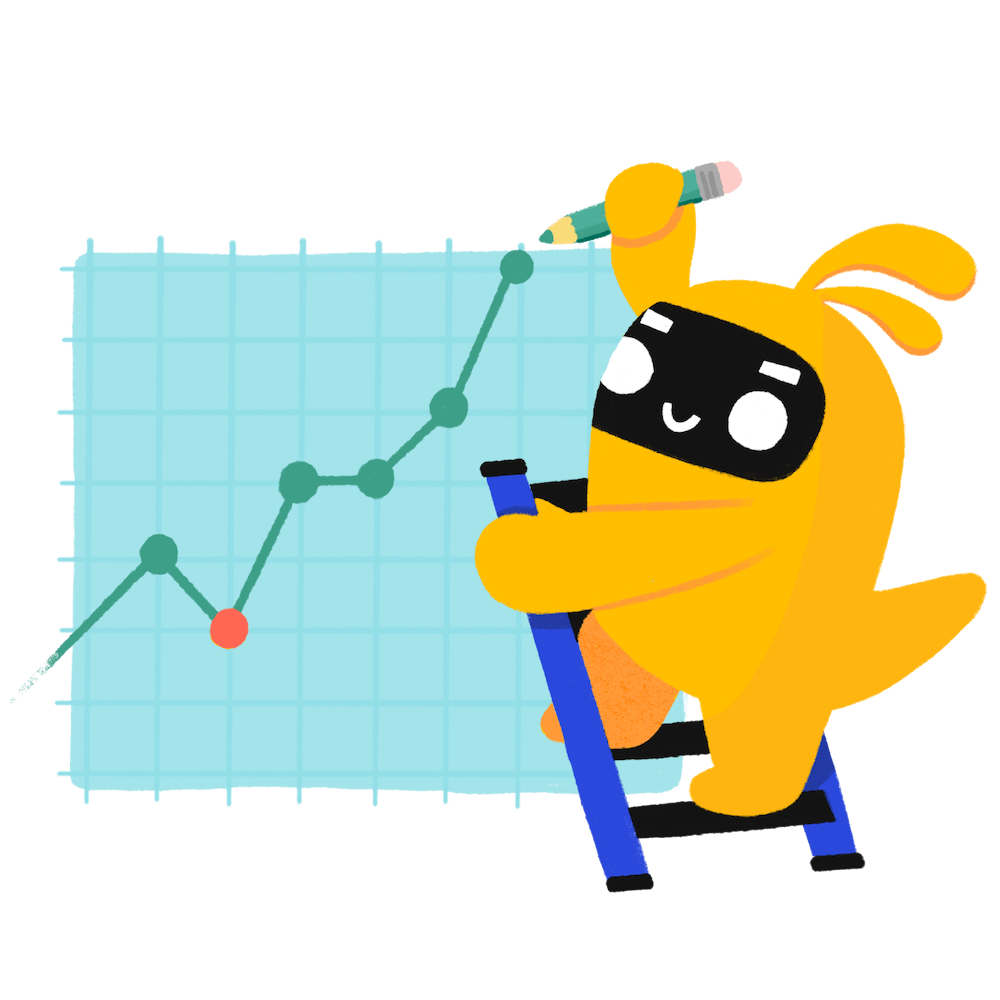4 customisable OKR examples for Innovation Management Team
What are Innovation Management Team OKRs?
The Objective and Key Results (OKR) framework is a simple goal-setting methodology that was introduced at Intel by Andy Grove in the 70s. It became popular after John Doerr introduced it to Google in the 90s, and it's now used by teams of all sizes to set and track ambitious goals at scale.
Formulating strong OKRs can be a complex endeavor, particularly for first-timers. Prioritizing outcomes over projects is crucial when developing your plans.
We've tailored a list of OKRs examples for Innovation Management Team to help you. You can look at any of the templates below to get some inspiration for your own goals.
If you want to learn more about the framework, you can read our OKR guide online.
Building your own Innovation Management Team OKRs with AI
While we have some examples available, it's likely that you'll have specific scenarios that aren't covered here. You can use our free AI generator below or our more complete goal-setting system to generate your own OKRs.
Feel free to explore our tools:
- Use our free OKR generator
- Use Tability, a complete platform to set and track OKRs and initiatives, including a GPT-4 powered goal generator
Our customisable Innovation Management Team OKRs examples
You'll find below a list of Objectives and Key Results templates for Innovation Management Team. We also included strategic projects for each template to make it easier to understand the difference between key results and projects.
Hope you'll find this helpful!
1. OKRs to enhance innovation manager's mastery of business requirements
Enhance innovation manager's mastery of business requirements
Complete 3 advanced courses on business requirements analysis by quarter-end
Complete all coursework by quarter-end
Enroll in these courses immediately
Select 3 advanced courses on business requirements analysis
Show 30% improvement in speed and precision of drafting business requirement documents
Use standardized templates to ensure consistent quality
Attend workshops on efficient business requirement drafting
Practice time management skills for quicker drafting
Inspect and accurately identify business requirements in 5 real-case scenarios
Review company documents to understand existing business processes
Analyze and document findings from five case scenarios
Conduct interviews with stakeholders to identify needs
2. OKRs to enhance synergy between startup house and startup ecosystem
Enhance synergy between startup house and startup ecosystem
Expand network with 15 new startup ecosystem partners by end of next quarter
Reach out with partnership proposals to potential partners
Identify potential startup ecosystem partners for collaboration
Follow up regularly and establish formal partnerships
Develop and organize 4 collaborative innovation workshops for startup house members
Coordinate logistics, including location, materials, and guest speakers
Determine workshop topics and objectives tailored to startup house members
Create and distribute workshop schedules, invitations and promotional materials
Facilitate 3 successful partnerships between startup house members and ecosystem players
Identify potential partners within startup house members and ecosystem players
Organize introductory meetings between identified parties
Support negotiations to formalize partnership agreements
3. OKRs to enhance provision of advisory services
Enhance provision of advisory services
Attain 25% more client engagements for advisory services by quarter end
Offer discounted packages for new clients
Conduct webinars to showcase expertise
Implement aggressive marketing strategies for advisory services
Offer 3 new advisory services that cater to specific client needs
Implement and market new advisory services
Research current client's needs to identify gaps in advisory services
Develop three new advisory service proposals
Improve client satisfaction rate by 15% through superior advisory service
Further customize advisory approaches for individual clients
Implement ongoing customer service training for advisory staff
Routinely solicit client feedback on advisory services
4. OKRs to position X as an integral part of the innovation ecosystem
Position X as an integral part of the innovation ecosystem
Increase brand awareness and reputation by 10% as measured by NPS and engagement metrics
Improve customer service to elevate customer experiences and satisfaction
Collaborate with influencers within the industry to promote the brand
Develop and implement a targeted social media advertising campaign
Secure 5 strategic partnerships with ecosystem influencers by the quarter's end
Develop tailored partnership proposals for each influencer
Identify key influencers in our industry's ecosystem
Initiate discussions and secure agreements
Demonstrate X's value via 3 high-impact projects successfully launched and executed
Innovation Management Team OKR best practices to boost success
Generally speaking, your objectives should be ambitious yet achievable, and your key results should be measurable and time-bound (using the SMART framework can be helpful). It is also recommended to list strategic initiatives under your key results, as it'll help you avoid the common mistake of listing projects in your KRs.
Here are a couple of best practices extracted from our OKR implementation guide 👇
Tip #1: Limit the number of key results
Having too many OKRs is the #1 mistake that teams make when adopting the framework. The problem with tracking too many competing goals is that it will be hard for your team to know what really matters.
We recommend having 3-4 objectives, and 3-4 key results per objective. A platform like Tability can run audits on your data to help you identify the plans that have too many goals.
 Tability's audit dashboard will highlight opportunities to improve OKRs
Tability's audit dashboard will highlight opportunities to improve OKRsTip #2: Commit to weekly OKR check-ins
Setting good goals can be challenging, but without regular check-ins, your team will struggle to make progress. We recommend that you track your OKRs weekly to get the full benefits from the framework.
Being able to see trends for your key results will also keep yourself honest.
 Tability's check-ins will save you hours and increase transparency
Tability's check-ins will save you hours and increase transparencyTip #3: No more than 2 yellow statuses in a row
Yes, this is another tip for goal-tracking instead of goal-setting (but you'll get plenty of OKR examples above). But, once you have your goals defined, it will be your ability to keep the right sense of urgency that will make the difference.
As a rule of thumb, it's best to avoid having more than 2 yellow/at risk statuses in a row.
Make a call on the 3rd update. You should be either back on track, or off track. This sounds harsh but it's the best way to signal risks early enough to fix things.
How to turn your Innovation Management Team OKRs in a strategy map
Your quarterly OKRs should be tracked weekly in order to get all the benefits of the OKRs framework. Reviewing progress periodically has several advantages:
- It brings the goals back to the top of the mind
- It will highlight poorly set OKRs
- It will surface execution risks
- It improves transparency and accountability
Spreadsheets are enough to get started. Then, once you need to scale you can use a proper OKR platform to make things easier.
 Tability's Strategy Map makes it easy to see all your org's OKRs
Tability's Strategy Map makes it easy to see all your org's OKRsIf you're not yet set on a tool, you can check out the 5 best OKR tracking templates guide to find the best way to monitor progress during the quarter.
More Innovation Management Team OKR templates
We have more templates to help you draft your team goals and OKRs.
OKRs to implement comprehensive security training for all staff
OKRs to enhance app personalization and customization
OKRs to improve indirect purchasing to support HR's talent strategies
OKRs to achieve timely and quality delivery of API projects
OKRs to achieve proficient utilization of the ERP system
OKRs to land and expand through product stickiness
OKRs resources
Here are a list of resources to help you adopt the Objectives and Key Results framework.
- To learn: What is the meaning of OKRs
- Blog posts: ODT Blog
- Success metrics: KPIs examples
Create more examples in our app
You can use Tability to create OKRs with AI – and keep yourself accountable 👀
Tability is a unique goal-tracking platform built to save hours at work and help teams stay on top of their goals.
 1 Create your workspace
1 Create your workspace 2 Build plans in seconds with AI
2 Build plans in seconds with AI 3Track your progress
3Track your progress